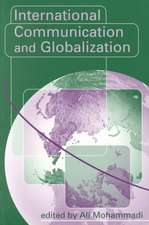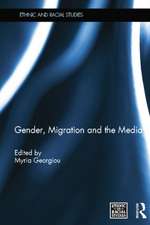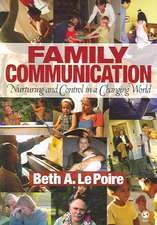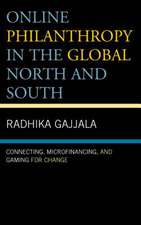The SAGE Handbook of Media and Migration
Editat de Kevin Smets, Koen Leurs, Myria Georgiou, Saskia Witteborn, Radhika Gajjalaen Limba Engleză Hardback – 13 noi 2019
The SAGE Handbook of Media and Migration offers a comprehensive overview of media and migration through new research, as well as a review of present scholarship in this expanding and promising field. It explores key interdisciplinary concepts and methodologies, and how these are challenged by new realities and the links between contemporary migration patterns and its use of mediated processes. Although primarily grounded in media and communication studies, the Handbook builds on research in the fields of sociology, anthropology, political science, urban studies, science and technology studies, human rights, development studies, and gender and sexuality studies, to bring to the forefront key theories, concepts and methodological approaches to the study of the movement of people.
In seven parts, the Handbook dissects important areas of cross-disciplinary and generational discourse for graduate students, early career researcher, migration management practitioners, and academics in the fields of media and migration studies, international development, communication studies, and the wider social science discipline.
Part One: Keywords and Legacies
Part Two: Methodologies
Part Three: Communities
Part Four: Representations
Part Five: Borders and Rights
Part Six: Spatialities
Part Seven: Conflicts
Preț: 1124.41 lei
Preț vechi: 1540.29 lei
-27% Nou
Puncte Express: 1687
Preț estimativ în valută:
215.15€ • 224.66$ • 177.67£
215.15€ • 224.66$ • 177.67£
Carte tipărită la comandă
Livrare economică 15-29 aprilie
Preluare comenzi: 021 569.72.76
Specificații
ISBN-13: 9781526447210
ISBN-10: 1526447215
Pagini: 700
Dimensiuni: 184 x 246 x 42 mm
Greutate: 1.4 kg
Ediția:1
Editura: SAGE Publications
Colecția Sage Publications Ltd
Locul publicării:London, United Kingdom
ISBN-10: 1526447215
Pagini: 700
Dimensiuni: 184 x 246 x 42 mm
Greutate: 1.4 kg
Ediția:1
Editura: SAGE Publications
Colecția Sage Publications Ltd
Locul publicării:London, United Kingdom
Recenzii
Due to the range of its themes, approaches, voices and contexts, this volume will be an indispensable guide to all scholars working on migration and media, and will furthermore open up a new space for methodological and conceptual reflection on a world in which movement and mediation are two sides of the same coin.
Scholarship on media and migration research has exploded in recent years. This outstanding volume captures the breadth and urgency of this important and rapidly-evolving work. A must-read for anyone working on media, migration and displacement.
This volume of over 50 chapters traverses enormous terrain in interrogating the entanglements of migration and media, highlighting the politics of encounter and the powerful combinations and permutations that shape contemporary migrant lives across the globe. What is truly excellent is the timely focus on social media, data science and digital technologies, and the impact on knowledge hierarchies and social justice in migration research.
.
Highlighting questions of power inequalities, processes, and dynamics within the intersections of media and migration, this book is a path-breaking vital and welcome contribution to migration and media studies. This Handbook provides insights into a central question of both these fields, that of representation and mediation. With careful attention paid to definitions, methodologies, and emerging issues, this book will be invaluable to scholars and students alike.
The Sage Handbook of Media and Migration’ consists of 54 chapters divided into seven parts. It showcases an overview of recent research on media and migration by exploring diverse concepts and methodologies, grounded in media and communication studies, and aided by sociology, anthropology, political science, urban science and technology, human rights, development, and gender and sexuality studies.
By standing against a Eurocentric perspective, the editors have enabled the encounters of researchers from different regions of the world as well as of diverse epistemologies and methodologies in this area of study.
The urgent matter the editors aim to highlight with this work is how questions of mediation and the politics of representation are being led by global and local politics and how the media contribute to the development of acts of xenophobia and the reproduction of far-right ‘crisis’ discourses. By standing against a Eurocentric perspective, the editors have enabled the encounters of researchers from different regions of the world as well as of diverse epistemologies and methodologies in this area of study. This is why the prologue by the artist Tabita Rezaire is an invitation to a healing process, a ‘decolonial healing’, as she labels it.
Through this assemblage of scholarship, The Sage Handbook of Media and Migration represents a provocative gaze on the intersection of media and migration in diverse spheres, places, discourses, and narratives that are subject to micro-, meso-, and macro-analyses. In its attempt to critically challenge and resist a Eurocentric perspective, the book imagines new ways of addressing migration and media research that involve academic awareness and decolonial perspectives
I felt ‘at home’ reading this impressive collection of chapters, stimulated by their findings, diversity of topics and approaches, journeying from one country or refugee site to another, engaging with efforts to map uncertainty, empathizing with both researchers (many migrants themselves) and their study participants. The ‘at home’ feeling stems from the messy duality of meaning an individual may experience as a migrant that was so well captured by researchers in this handbook: at the mercy of institutions who themselves cope with the arrow of time, in the path of intended and unintended consequences of mediated (re)presentations, both agent and object, manifesting defeat and resilience, both a case number and dignifiedly alive.
Scholarship on media and migration research has exploded in recent years. This outstanding volume captures the breadth and urgency of this important and rapidly-evolving work. A must-read for anyone working on media, migration and displacement.
This volume of over 50 chapters traverses enormous terrain in interrogating the entanglements of migration and media, highlighting the politics of encounter and the powerful combinations and permutations that shape contemporary migrant lives across the globe. What is truly excellent is the timely focus on social media, data science and digital technologies, and the impact on knowledge hierarchies and social justice in migration research.
.
Highlighting questions of power inequalities, processes, and dynamics within the intersections of media and migration, this book is a path-breaking vital and welcome contribution to migration and media studies. This Handbook provides insights into a central question of both these fields, that of representation and mediation. With careful attention paid to definitions, methodologies, and emerging issues, this book will be invaluable to scholars and students alike.
The Sage Handbook of Media and Migration’ consists of 54 chapters divided into seven parts. It showcases an overview of recent research on media and migration by exploring diverse concepts and methodologies, grounded in media and communication studies, and aided by sociology, anthropology, political science, urban science and technology, human rights, development, and gender and sexuality studies.
By standing against a Eurocentric perspective, the editors have enabled the encounters of researchers from different regions of the world as well as of diverse epistemologies and methodologies in this area of study.
The urgent matter the editors aim to highlight with this work is how questions of mediation and the politics of representation are being led by global and local politics and how the media contribute to the development of acts of xenophobia and the reproduction of far-right ‘crisis’ discourses. By standing against a Eurocentric perspective, the editors have enabled the encounters of researchers from different regions of the world as well as of diverse epistemologies and methodologies in this area of study. This is why the prologue by the artist Tabita Rezaire is an invitation to a healing process, a ‘decolonial healing’, as she labels it.
This handbook is certainly timely given the number of migration crises around the globe, the rise of xenophobic far-Right political groups, and the ever-increasing role of digital media in both representing these crises and the people caught up in them, and providing an opportunity for the disenfranchised to represent themselves. […] In keeping with the principles of social justice and the ethos of cultural studies and media studies, the collection seeks to counter the Eurocentrism of current media messages about migrants.
Through this assemblage of scholarship, The Sage Handbook of Media and Migration represents a provocative gaze on the intersection of media and migration in diverse spheres, places, discourses, and narratives that are subject to micro-, meso-, and macro-analyses. In its attempt to critically challenge and resist a Eurocentric perspective, the book imagines new ways of addressing migration and media research that involve academic awareness and decolonial perspectives
I felt ‘at home’ reading this impressive collection of chapters, stimulated by their findings, diversity of topics and approaches, journeying from one country or refugee site to another, engaging with efforts to map uncertainty, empathizing with both researchers (many migrants themselves) and their study participants. The ‘at home’ feeling stems from the messy duality of meaning an individual may experience as a migrant that was so well captured by researchers in this handbook: at the mercy of institutions who themselves cope with the arrow of time, in the path of intended and unintended consequences of mediated (re)presentations, both agent and object, manifesting defeat and resilience, both a case number and dignifiedly alive.
Cuprins
Prologue: Decolonial Healing - Tabita Rezaire
Editorial Introduction: Media and Migration: Research Encounters - Kevin Smets, Koen Leurs, Myria Georgiou, Saskia Witteborn & Radhika Gajjala
Part 1: Keywords
Chapter 1: Mediation - Radha S. Hegde
Chapter 2: Diaspora as a Frame: How the Notion has Reshaped Migration Studies - Roza Tsagarousianou
Chapter 3: Postcolonial Theory - Sandra Ponzanesi
Chapter 4: Borders - Lilie Chouliaraki & Myria Georgiou
Chapter 5: Transnationalism, Inter-nationalism and Multicultural Questions - Koichi Iwabuchi
Chapter 6: Migration and the post-secular - Eva Midden
Chapter 7: Cosmopolitanism in the Anthropocene - Miyase Christensen
Chapter 8: Intersectionality - Alyssa Fisher, Kaitlyn Wauthier, & Radhika Gajjala
Chapter 9: Affect, Emotions and Feelings - Donya Alinejad & Domitilia Olivieri
Chapter 10: Connected Migrants - Dana Diminescu
Chapter 11: Digital Divides - Linda Leung
Chapter 12: Information Precarity - Melissa Wall
Chapter 13: Infrastructures - Koen Leurs
Chapter 14: The Political Economy of Digital Media, Migration and Race - Eugenia Siapera
Chapter 15: Beyond Media Studies of Migration - Kevin Robins
Chapter 16: Insurgent Academics - Roopika Risam
Part 2: Methodologies
Chapter 17: On Researching Climates of Hostility and Weathering - Yasmin Gunaratnam
Chapter 18: Refracting the Analytical Gaze: Studying Media Representations of Migrant Death at the Border - Karina Horsti
Chapter 19: Racializing Space. Gendering Place: Black Feminism, Ethnography, and Methodological Challenges Online and IRL - Kishonna Gray
Chapter 20: Mobile Methods: Doing Migration Research with the Help of Smartphones - Katja Kaufmann
Chapter 21: Mobility, Media, and Data Politics - Will L. Allen
Chapter 22: Twitter Influentials and the Networked Publics' Engagement with the Rohingya Crisis in Arabic and English - Ahmed Al-Rawi
Part 3: Communities
Chapter 23: The Performative Digital Africa: iROKOtv, Nollywood Televisuals, and Community Building in the African Digital Diaspora - Tori Omega Arthur
Chapter 24: Queer Migration and Digital Culture - Lukasz Szulc
Chapter 25: Out of Place: Refugees Navigating Nation, Self, and Culture in Former East Germany - Emily Edwards
Chapter 26: (Re)loading Identity and Affective Capital Online: The case of Diaspora Basques on Facebook - Pedro J. Oiarzabal
Chapter 27: Russophone Diasporic Journalism: Production and Producers in the Changing Communicative Landscape - Olga Voronova, Liudmila Voronova, & Dmitry Yagodin
Chapter 28: Airtime and the public sphere: Candela Radio’s contribution to the integration of immigrant communities in the Basque Country - Irati Agirreazkuenaga & Estitxu Garai-Artetxe
Chapter 29: Recasting Home: Indian Immigrants and the World Wide Web - Madhavi Mallapragada
Chapter 30: Migrations and the Media between Asia and Latin America: Japanese Brazilians in Tokyo and Sao Paulo - Jessica Retis
Part 4: Borders and Rights
Chapter 31: Borders and the Contagious Nature of Mediation - Huub Dijstelbloem
Chapter 32: The Oromo Movement and Ethiopian Border-making Using Social Media - Payal Arora
Chapter 33: Digital Humanitarianism in a Refugee Camp - Léa Macias
Chapter 34: The Politics of Vulnerability and Protection: Analysing the Case of LGBT Asylum Seekers in the Netherlands in Light of Securitization and Homonationalist Discourses - Christine Quinan, Dana Theewis, & Cecilia Cienfuegos
Chapter 35: Young Displaced Women in Colombia and Media Use - Melissa Chacon
Chapter 36: Communication Rights for Immigrants - Cees Hamelink & Maria Hagan
Part 5: Representations
Chapter 37: Migration, Race/Ethnicity and Sports Media Content - Jacco van Sterkenburg
Chapter 38: Immigrant Families in European Cinema - Daniela Beghahn
Chapter 39: Breaking the Silence: From Representations of Victims and Threat Towards Spaces of Voice - Kaarina Nikunen
Chapter 40: Making Space for Oneself: Minorities and Self-Representation in Popular Media - Rosemary Pennington
Chapter 41: Representations from a Multi-Stakeholders Perspective: A Research Agenda - Leen d'Haenens & Willem Joris
Part 6: Spatialities
Chapter 42: The Migration-Mobility Nexus: The Politics of Interface, Labor and Gender - Saskia Witteborn & Zhuoxiao Xie
Chapter 43: The Cog that Imagines the System: Data Migration and Migrant Bodies in the Wake of Aadhaar - Nishant Shah
Chapter 44: Automation versus Nationalism: Challenges to the Future of Work in the Software Industry - Nilanjan Raghunath
Chapter 45: Civic Media, & Placemaking; (Re)Claiming Urban & Migrant Rights Across Digital and Physical Spaces - Giota Alevizou
Chapter 46: Digital Place-Making Practices and Daily Struggles of Venezuelan Refugees in Brazil - Amanda Paz Alencar
Chapter 47: Being at Home on Social Media: Online Place-Making among the Kurds in Turkey and Rural Migrants in China - Elisabetta Costa & JinXie Wang
Chapter 48: YouTube as an Intercultural Space: Digital Narratives of Younger-Generation Migrants - Sherry Yu
Part 7: Conflicts
Chapter 49: Racisms, Migration and Media: A Reflection on Mutable Understandings and Shifting 'Problem Populations' - Gavan Titley
Chapter 50: Anti-Immigrant Sentiments and Mobilization on the Internet - Mattias Ekman
Chapter 51: National Politics, Transnational Resistance: Alevi Television during the State of Emergency in Turkey (2016-2018) - Kumru Berfin Emin Cetin
Chapter 52: Diaspora Activism in Host and Home Countries: Motivations, Possibilities and Limits - Christine Ogan
Chapter 53: Media, Recognition and Conflict-Generated Diaspora: the Somali Diaspora as a Case Study - Idil Osman
Chapter 54: Conflict and Migration in Lebanese Graphic Narratives - Rasha Chatta
Epilogue: On Giving and Being a Voice - Zaina Erhaim, Yazan Badran, & Kevin Smets
Epilogue: Self-Reflections on Migration and Exile - Bermal Aydin
Editorial Introduction: Media and Migration: Research Encounters - Kevin Smets, Koen Leurs, Myria Georgiou, Saskia Witteborn & Radhika Gajjala
Part 1: Keywords
Chapter 1: Mediation - Radha S. Hegde
Chapter 2: Diaspora as a Frame: How the Notion has Reshaped Migration Studies - Roza Tsagarousianou
Chapter 3: Postcolonial Theory - Sandra Ponzanesi
Chapter 4: Borders - Lilie Chouliaraki & Myria Georgiou
Chapter 5: Transnationalism, Inter-nationalism and Multicultural Questions - Koichi Iwabuchi
Chapter 6: Migration and the post-secular - Eva Midden
Chapter 7: Cosmopolitanism in the Anthropocene - Miyase Christensen
Chapter 8: Intersectionality - Alyssa Fisher, Kaitlyn Wauthier, & Radhika Gajjala
Chapter 9: Affect, Emotions and Feelings - Donya Alinejad & Domitilia Olivieri
Chapter 10: Connected Migrants - Dana Diminescu
Chapter 11: Digital Divides - Linda Leung
Chapter 12: Information Precarity - Melissa Wall
Chapter 13: Infrastructures - Koen Leurs
Chapter 14: The Political Economy of Digital Media, Migration and Race - Eugenia Siapera
Chapter 15: Beyond Media Studies of Migration - Kevin Robins
Chapter 16: Insurgent Academics - Roopika Risam
Part 2: Methodologies
Chapter 17: On Researching Climates of Hostility and Weathering - Yasmin Gunaratnam
Chapter 18: Refracting the Analytical Gaze: Studying Media Representations of Migrant Death at the Border - Karina Horsti
Chapter 19: Racializing Space. Gendering Place: Black Feminism, Ethnography, and Methodological Challenges Online and IRL - Kishonna Gray
Chapter 20: Mobile Methods: Doing Migration Research with the Help of Smartphones - Katja Kaufmann
Chapter 21: Mobility, Media, and Data Politics - Will L. Allen
Chapter 22: Twitter Influentials and the Networked Publics' Engagement with the Rohingya Crisis in Arabic and English - Ahmed Al-Rawi
Part 3: Communities
Chapter 23: The Performative Digital Africa: iROKOtv, Nollywood Televisuals, and Community Building in the African Digital Diaspora - Tori Omega Arthur
Chapter 24: Queer Migration and Digital Culture - Lukasz Szulc
Chapter 25: Out of Place: Refugees Navigating Nation, Self, and Culture in Former East Germany - Emily Edwards
Chapter 26: (Re)loading Identity and Affective Capital Online: The case of Diaspora Basques on Facebook - Pedro J. Oiarzabal
Chapter 27: Russophone Diasporic Journalism: Production and Producers in the Changing Communicative Landscape - Olga Voronova, Liudmila Voronova, & Dmitry Yagodin
Chapter 28: Airtime and the public sphere: Candela Radio’s contribution to the integration of immigrant communities in the Basque Country - Irati Agirreazkuenaga & Estitxu Garai-Artetxe
Chapter 29: Recasting Home: Indian Immigrants and the World Wide Web - Madhavi Mallapragada
Chapter 30: Migrations and the Media between Asia and Latin America: Japanese Brazilians in Tokyo and Sao Paulo - Jessica Retis
Part 4: Borders and Rights
Chapter 31: Borders and the Contagious Nature of Mediation - Huub Dijstelbloem
Chapter 32: The Oromo Movement and Ethiopian Border-making Using Social Media - Payal Arora
Chapter 33: Digital Humanitarianism in a Refugee Camp - Léa Macias
Chapter 34: The Politics of Vulnerability and Protection: Analysing the Case of LGBT Asylum Seekers in the Netherlands in Light of Securitization and Homonationalist Discourses - Christine Quinan, Dana Theewis, & Cecilia Cienfuegos
Chapter 35: Young Displaced Women in Colombia and Media Use - Melissa Chacon
Chapter 36: Communication Rights for Immigrants - Cees Hamelink & Maria Hagan
Part 5: Representations
Chapter 37: Migration, Race/Ethnicity and Sports Media Content - Jacco van Sterkenburg
Chapter 38: Immigrant Families in European Cinema - Daniela Beghahn
Chapter 39: Breaking the Silence: From Representations of Victims and Threat Towards Spaces of Voice - Kaarina Nikunen
Chapter 40: Making Space for Oneself: Minorities and Self-Representation in Popular Media - Rosemary Pennington
Chapter 41: Representations from a Multi-Stakeholders Perspective: A Research Agenda - Leen d'Haenens & Willem Joris
Part 6: Spatialities
Chapter 42: The Migration-Mobility Nexus: The Politics of Interface, Labor and Gender - Saskia Witteborn & Zhuoxiao Xie
Chapter 43: The Cog that Imagines the System: Data Migration and Migrant Bodies in the Wake of Aadhaar - Nishant Shah
Chapter 44: Automation versus Nationalism: Challenges to the Future of Work in the Software Industry - Nilanjan Raghunath
Chapter 45: Civic Media, & Placemaking; (Re)Claiming Urban & Migrant Rights Across Digital and Physical Spaces - Giota Alevizou
Chapter 46: Digital Place-Making Practices and Daily Struggles of Venezuelan Refugees in Brazil - Amanda Paz Alencar
Chapter 47: Being at Home on Social Media: Online Place-Making among the Kurds in Turkey and Rural Migrants in China - Elisabetta Costa & JinXie Wang
Chapter 48: YouTube as an Intercultural Space: Digital Narratives of Younger-Generation Migrants - Sherry Yu
Part 7: Conflicts
Chapter 49: Racisms, Migration and Media: A Reflection on Mutable Understandings and Shifting 'Problem Populations' - Gavan Titley
Chapter 50: Anti-Immigrant Sentiments and Mobilization on the Internet - Mattias Ekman
Chapter 51: National Politics, Transnational Resistance: Alevi Television during the State of Emergency in Turkey (2016-2018) - Kumru Berfin Emin Cetin
Chapter 52: Diaspora Activism in Host and Home Countries: Motivations, Possibilities and Limits - Christine Ogan
Chapter 53: Media, Recognition and Conflict-Generated Diaspora: the Somali Diaspora as a Case Study - Idil Osman
Chapter 54: Conflict and Migration in Lebanese Graphic Narratives - Rasha Chatta
Epilogue: On Giving and Being a Voice - Zaina Erhaim, Yazan Badran, & Kevin Smets
Epilogue: Self-Reflections on Migration and Exile - Bermal Aydin
Descriere
The SAGE Handbook of Media and Migration offers a comprehensive overview of media and migration through new research, as well as a review of present scholarship in this expanding and promising field. It explores key interdisciplinary concepts and methodologies, and how these are challenged by new realities and the links between contemporary migration patterns and its use of mediated processes.











